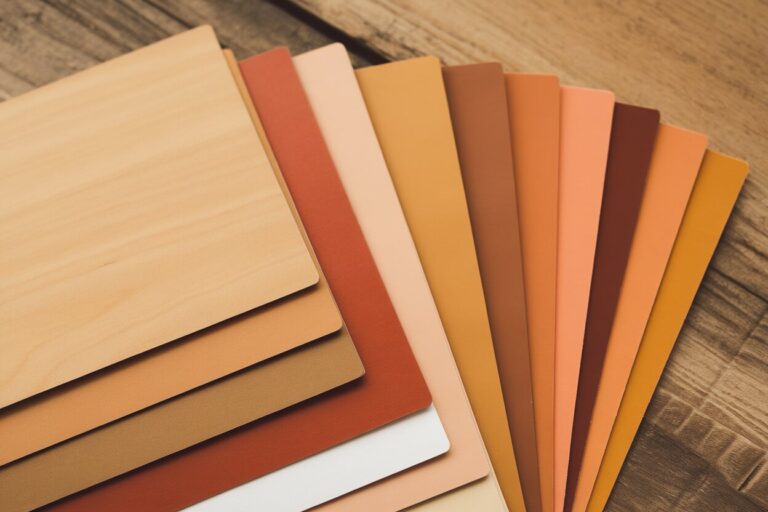In this blog, I will share the best colors that complement maple wood. Whether you’re designing a kitchen, living room, or bedroom, choosing the right color palette can make a big difference. The right shades can highlight maple’s natural warmth or create a striking contrast for a modern look.
Maple wood has golden, honey, and reddish undertones. Some colors blend seamlessly with its warmth, while others provide a bold contrast. Understanding these combinations helps you create a balanced and stylish space.
You’ll discover the best neutral, warm, cool, and bold colors that work with maple wood. I’ll also cover how to apply these colors to walls, flooring, furniture, and decor. By the end, you’ll have practical ideas to enhance your space effortlessly.
Understanding Maple Wood & Its Color Characteristics
Natural Tones of Maple Wood
Maple wood has a warm, natural beauty. Its color varies from light creamy white to golden honey. Some pieces may have a hint of reddish tones, giving them a richer appearance.
It’s fine, even grain makes it adaptable to different styles. Whether you prefer modern, rustic, or classic interiors, maple blends in effortlessly. It also takes stains well, allowing for customization.
Because of its light tones, maple wood helps brighten spaces. It reflects light, making rooms feel open and welcoming. This makes it a popular choice for flooring, cabinetry, and furniture.
Undertones & How They Influence Color Pairings
Maple’s warm undertones work well with earthy and deep hues. Colors like beige, terracotta, and rich browns enhance its natural warmth. These shades create a cozy, inviting atmosphere.
For contrast, cool colors like sage green, muted blue, and charcoal gray balance its golden tones. Soft grays and blues offer subtle contrast, while darker shades add boldness.
Stains and finishes affect how maple pairs with colors. A clear finish keeps its warmth, while darker stains add depth. Lighter stains tone it down, making it more neutral for different palettes.
Best Color Palettes for Maple Wood
Neutral & Soft Colors (For a Timeless Look)
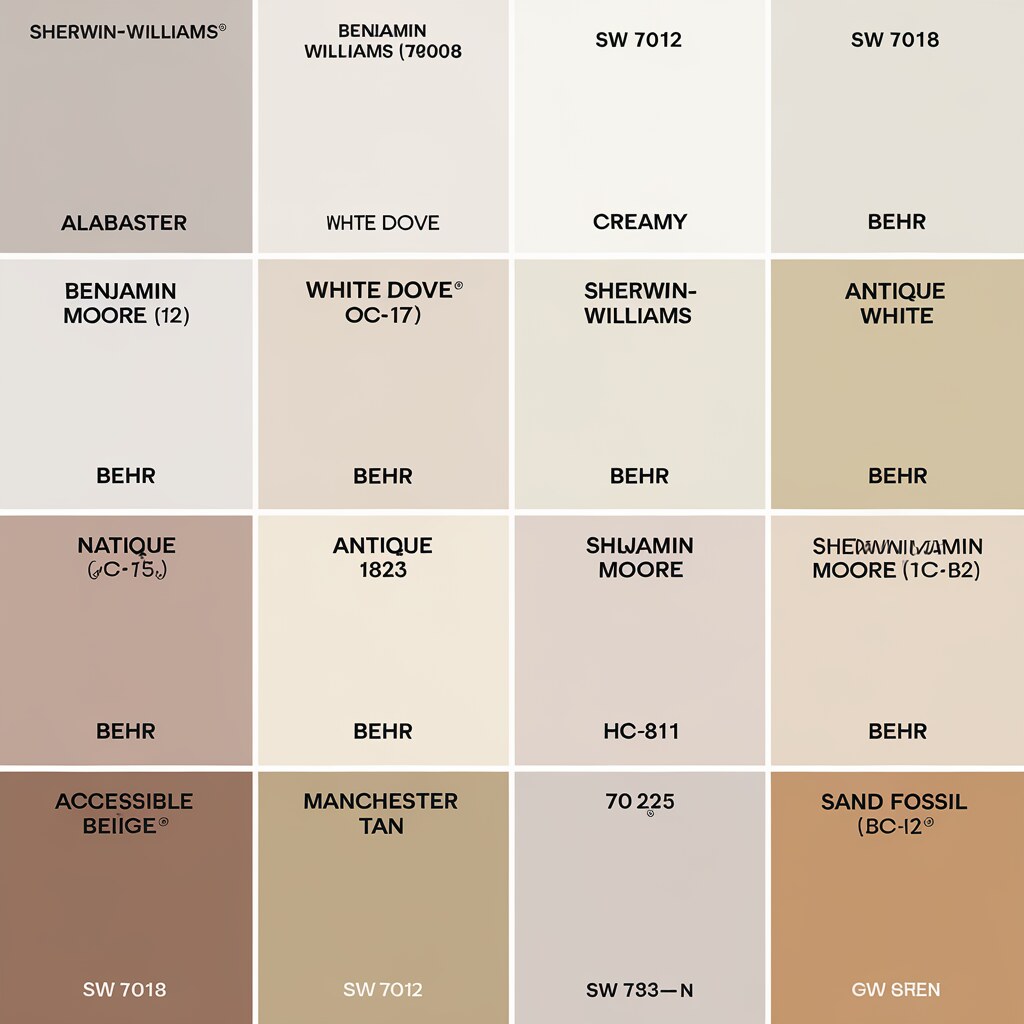
- Sherwin-Williams – Alabaster (SW 7008)
- Benjamin Moore – White Dove (OC-17)
- Behr – Swiss Coffee (12)
- Sherwin-Williams – Creamy (SW 7012)
- Benjamin Moore – Navajo White (OC-95)
- Behr – Antique White (1823)
- Sherwin-Williams – Accessible Beige (SW 7036)
- Benjamin Moore – Manchester Tan (HC-81)
- Behr – Sand Fossil (750C-3)
Neutral colors work well with maple wood, creating a clean and timeless aesthetic. Off-white brightens a space and highlights maple’s natural warmth. They make rooms feel airy and modern, especially in smaller areas.
Cream softness while blending seamlessly with maple’s golden tones. These shades create a cozy and inviting atmosphere without overwhelming the space. They work well in living rooms and bedrooms for a warm, understated look.
Beige provides a subtle contrast while maintaining warmth. These colors add sophistication without clashing with the maple’s undertones. They are ideal for walls, furniture, or textiles, offering a balanced and neutral backdrop.
Earthy & Warm Colors (For a Cozy, Inviting Atmosphere)
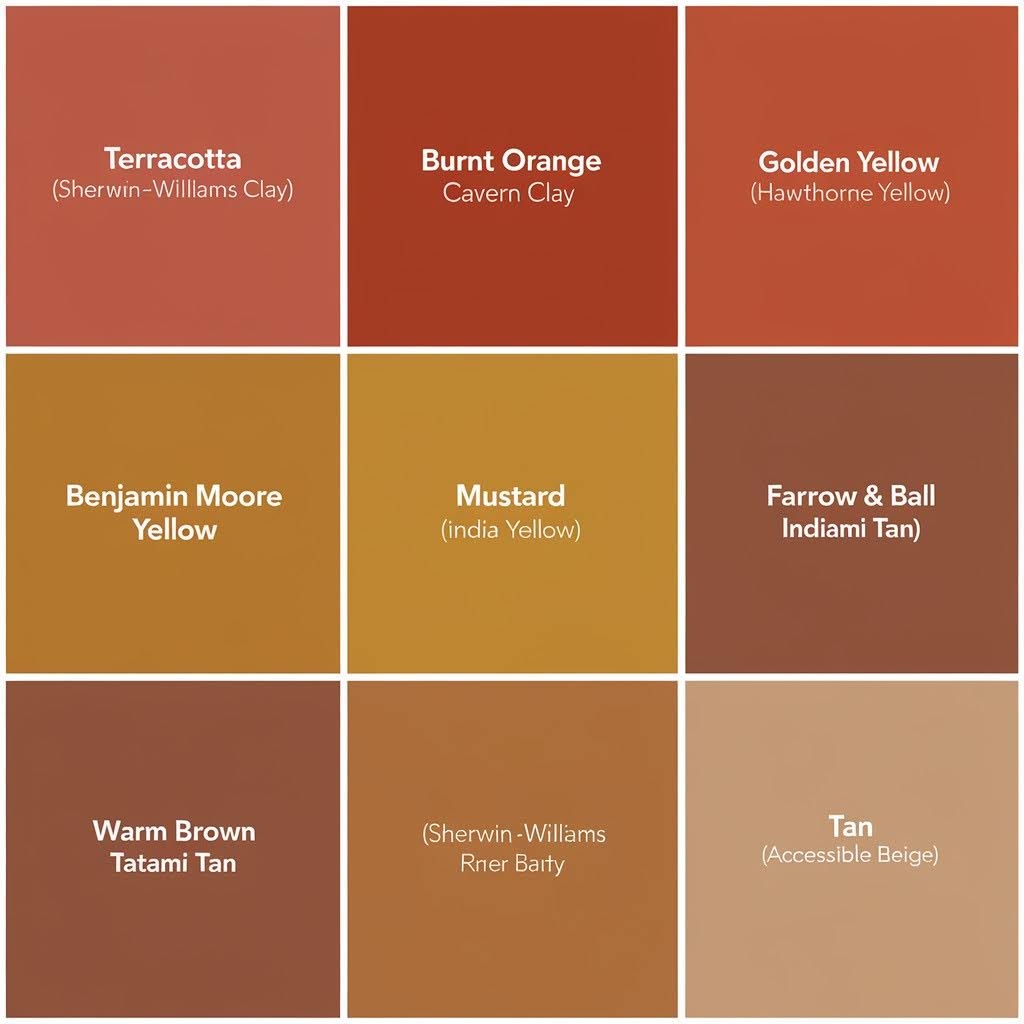
- Terracotta – Sherwin-Williams Cavern Clay (SW 7701)
- Burnt Orange – Behr Japanese Koi (PPU3-14)
- Golden Yellow – Benjamin Moore Hawthorne Yellow (HC-4)
- Mustard – Farrow & Ball India Yellow (No. 66)
- Warm Brown – Sherwin-Williams Tatami Tan (SW 6116)
- Tan – Behr Accessible Beige (PPU24-10)
Earthy shades enhance maple’s natural warmth, making spaces feel grounded and inviting. Terracotta and burnt orange deepen the maple’s golden hues, adding richness. These tones are great for accent walls, rugs, or decorative elements.
Golden yellow and mustard bring a bright, sun-kissed effect. They amplify the warmth of maple wood, creating an uplifting and cheerful environment. These shades are ideal for kitchens and dining areas.
Warm browns and tan complement maple for a rustic, nature-inspired appeal. Brown accents, whether in furniture or decor, create a cohesive and harmonious look. Tan textiles and upholstery add warmth without overwhelming the space.
Cool & Contrasting Colors (For a Balanced, Modern Feel)
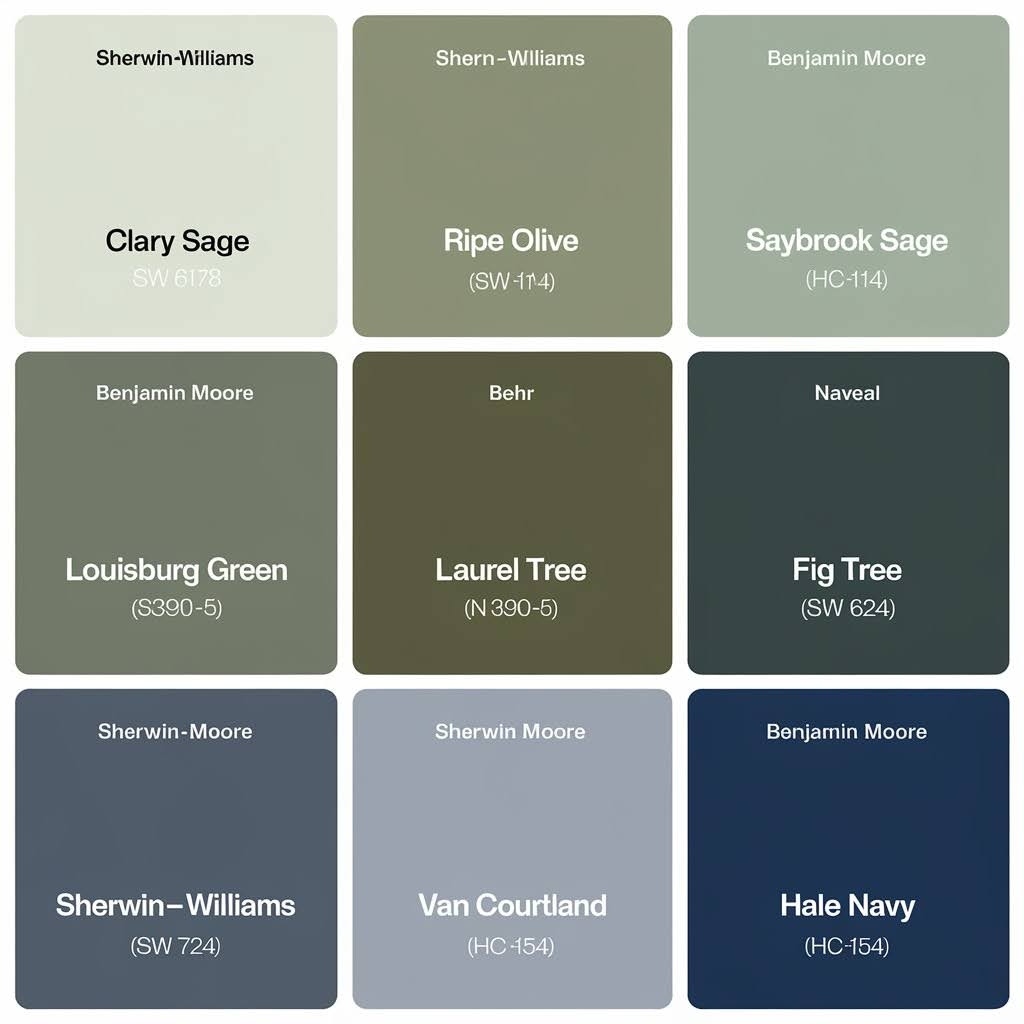
- Sherwin-Williams: Clary Sage (SW 6178), Ripe Olive (SW 6209)
- Benjamin Moore: Saybrook Sage (HC-114), Louisburg Green (HC-113)
- Behr: Laurel Tree (S390-5), Fig Tree (N390-6)
- Sherwin-Williams: Smoky Blue (SW 7604), Naval (SW 6244)
- Benjamin Moore: Van Courtland Blue (HC-145), Hale Navy (HC-154)
- Behr: Norwester (MQ5-59), Starless Night (PPU14-20)
- Sherwin-Williams: Dovetail (SW 7018), Iron Ore (SW 7069)
- Benjamin Moore: Kendall Charcoal (HC-166), Wrought Iron (2124-10)
- Behr: Cracked Pepper (PPU18-01), Carbon (N520-7)
Cool colors balance the maple wood’s warmth, offering a fresh and modern contrast. Sage green and olive green introduce a natural, calming effect. These colors pair well with maple cabinetry, especially in kitchens and living spaces.
Muted blue and navy blue add depth and sophistication. Lighter blues create a subtle contrast, while navy offers a bold, striking balance. These shades are excellent for walls, upholstery, or decorative accents.
Deep gray and charcoal bring a contemporary, dramatic contrast. These colors add refinement and make maple wood stand out. Charcoal walls or furniture pieces provide a sleek, modern touch without overpowering the space.
Bold & Dramatic Colors (For a High-Impact Design)
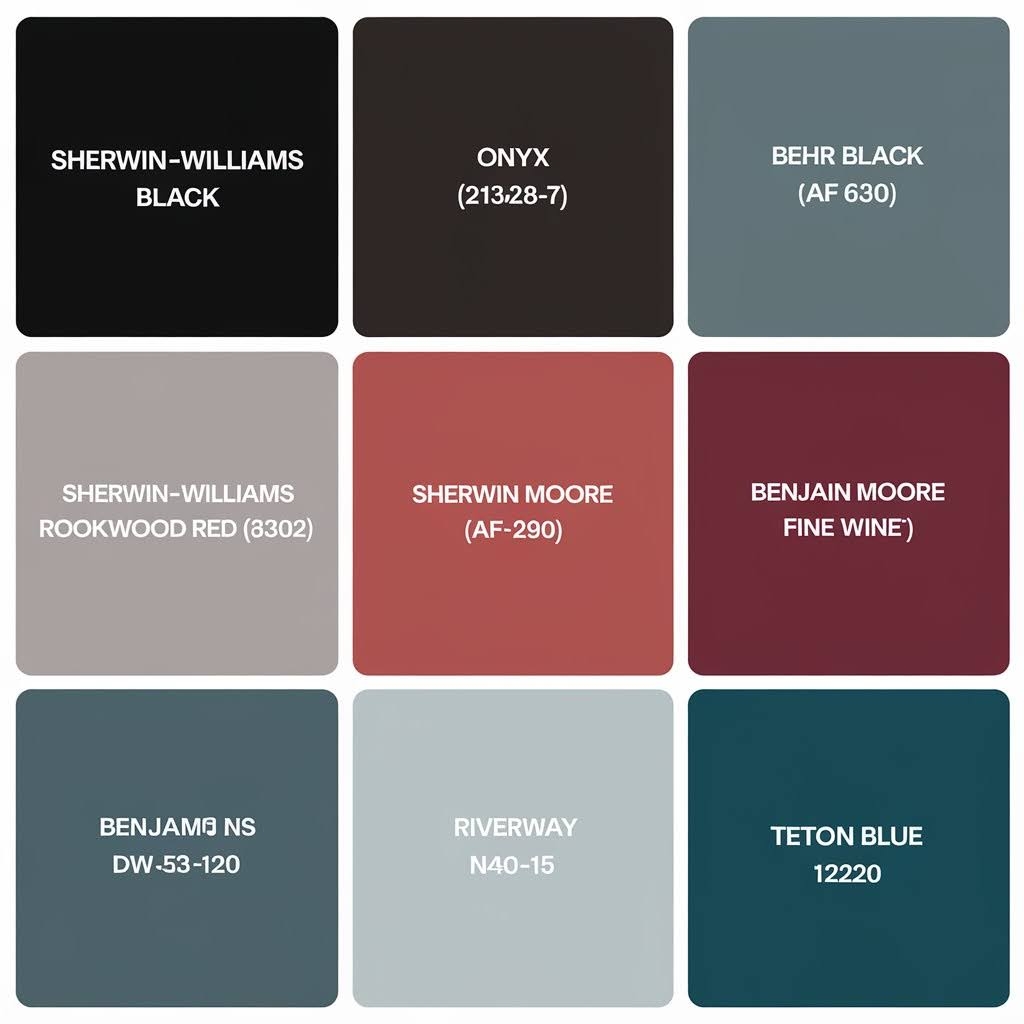
- Sherwin-Williams Tricorn Black (SW 6258)
- Benjamin Moore Onyx (2133-10)
- Behr Black (N510-7)
- Sherwin-Williams Rookwood Red (SW 2802)
- Benjamin Moore Caliente (AF-290)
- Behr Red Pepper (PPU2-02)
- Sherwin-Williams Fine Wine (SW 6307)
- Benjamin Moore Dinner Party (AF-300)
- Behr Forbidden Red (PPU1-15)
- Sherwin-Williams Riverway (SW 6222)
- Benjamin Moore Dark Teal (2053-20)
- Behr Teton Blue (N490-5)
For a statement look, bold colors create striking contrast against maple wood. Black and dark tones bring a sleek and moody feel. Black cabinetry or decor elements add depth and modern elegance.
Deep red and burgundy introduce a luxurious and rich atmosphere. These colors enhance maple’s golden hues, making them ideal for dining rooms or accent walls. They add warmth and a touch of drama to any space.
Dark teal and forest green provide a deep yet harmonious effect. These jewel tones contrast beautifully with the maple’s lighter tones, adding sophistication. They work well for bold accent pieces or statement furniture.
Applying Colors in Different Areas of Your Home
Walls & Flooring (The Foundation of the Room)
Walls and flooring set the tone for any space with maple wood. The right colors can either blend seamlessly with maple’s warmth or create contrast for a more dynamic look. Choosing the right balance helps define the overall style and feel of the room.
Wall Colors That Work with Maple Wood
Soft neutrals create a seamless and balanced look. Shades like white, cream, and light beige allow maple’s natural warmth to shine. These colors make a space feel open, bright, and timeless. They are perfect for creating a calming, neutral backdrop.
For contrast, deep greens and blues add richness and depth. Sage green, navy blue, or charcoal gray provide a bold yet elegant look. These shades make maple wood stand out while adding personality to the space.
Choosing between contrast and cohesion depends on the mood you want to create. Neutral walls offer a soft, inviting feel, while darker tones add drama and sophistication. A mix of both, such as neutral walls with bold accent colors, can create a balanced and stylish design.
Flooring Choices
Light wood or neutral tiles create an open and airy feel. Pale oak, beige tiles, or light gray flooring complement maple’s warmth without overpowering it. These options make small spaces appear larger and work well in modern or minimalist designs.
Dark flooring, such as walnut or deep brown tiles, adds depth and contrast. It grounds the space and makes maple cabinetry or furniture stand out. Dark floors work well in larger rooms, adding a sense of warmth and coziness.
Area rugs help transition between flooring and maple wood elements. A neutral rug softens the space, while a patterned rug adds visual interest. Rugs also define different areas within a room, bringing warmth and texture to the overall design.
Furniture & Decor Accents
Furniture and decor complete the look of a space with maple wood. The right upholstery, accent pieces, and wood combinations can enhance its warmth or create contrast. Thoughtful choices bring balance and personality to the room.
Upholstery & Textiles
Soft, neutral fabrics, like beige, cream, or light gray, create a harmonious and calming effect. These colors blend with maple’s warmth and keep the space light and inviting. Linen and cotton textures add softness and a relaxed feel.
For contrast, bold upholstery in deep blue, forest green, or burnt orange makes a statement. These colors add depth and vibrancy while balancing the wood’s golden tones. Velvet or woven fabrics bring texture and richness to the design.
Accent Pieces
Throw pillows and rugs are easy ways to add color and texture. Neutral rugs create a seamless look, while patterned or colorful rugs add interest. Pillows in complementary or contrasting tones can tie the whole design together.
Artwork also plays a key role. Black-and-white prints, nature-inspired paintings, or abstract designs can enhance the space. Metallic or wooden frames help integrate the artwork with the rest of the decor.
Mixing Different Wood Tones
Blending maple with other wood tones adds depth and variety. Lighter woods, like birch or white oak, create a soft and layered look. This pairing works well in Scandinavian or minimalist designs.
Darker woods, such as walnut or mahogany, add contrast and elegance. This mix creates a rich, sophisticated feel in both modern and traditional spaces. Using wood in different finishes, matte, gloss, or distressed, adds even more visual interest.
Combining Maple Wood with Other Materials
Pairing maple wood with the right materials enhances its natural beauty. Metals, stone, and textiles can either highlight its warmth or create a striking contrast. Thoughtful combinations bring balance, depth, and personality to any space.
Metals & Hardware
Brass and gold add a touch of vintage charm and elegance. Their warm tones complement maple’s golden hues, creating a cohesive and inviting look. These finishes work well for cabinet handles, light fixtures, and decorative accents.
For a sleek, modern contrast, matte black hardware makes a bold statement. Black handles, faucets, and lighting fixtures create a sharp definition against the maple’s warm tones. This combination works well in contemporary and industrial-style spaces.
Silver and chrome finishes offer a clean, polished look. They add a cool contrast to maple wood’s warmth, making the space feel fresh and modern. Stainless steel appliances and chrome fixtures enhance a bright and airy kitchen design.
Stones & Countertops
Light countertops, such as white quartz or marble, create a soft and elegant contrast. They brighten the space and highlight maple’s natural tones. This combination works well in modern, farmhouse, or minimalist kitchens.
Dark stone countertops, like black granite or soapstone, add drama and depth. They create a bold contrast, making maple cabinetry or furniture stand out. This choice suits contemporary and high-end designs that embrace rich, moody aesthetics.
Marble, quartz, and granite each bring unique textures and patterns. Quartz offers a sleek, low-maintenance option, while marble adds timeless sophistication. Granite provides durability with natural variation, complementing maple’s organic warmth.
Fabric & Textiles
Soft, warm textiles enhance the inviting feel of maple wood. Linen, cotton, and wool in neutral shades like beige, ivory, or taupe create a cozy and layered look. These fabrics work well for curtains, upholstery, and bedding.
For contrast, bold-colored textiles add personality. Deep blues, forest greens, or burnt oranges create a striking visual balance against maple’s warmth. Throw pillows, rugs, or accent chairs in these colors bring energy to the space.
Textures also play a role in defining the look. Velvet adds luxury, woven fabrics provide depth, and patterned textiles introduce movement. Mixing soft and bold textiles helps achieve a well-balanced, dynamic interior.
Conclusion
Maple wood pairs beautifully with soft neutrals, warm earth tones, and deep contrasting shades. The right balance depends on your style and space.
Experiment with textures, accents, and finishes to create a look that reflects your vision. Whether you prefer cozy warmth or modern contrast, maple wood adapts effortlessly.
FAQ
How Does Natural Light Enhance Maple Wood’s Tones?
Natural light highlights maple’s golden and honey hues, making spaces feel warm and inviting. Sunlight enhances its natural grain, adding depth and richness. Large windows or skylights maximize this effect, creating a bright and airy atmosphere.
Warm vs. Cool Artificial Light – Which Works Best for Maple Wood?
Warm artificial light enhances maple’s golden tones, creating a cozy ambiance. Cool lighting adds contrast, making the wood appear lighter and more modern. Choose warm lighting for a traditional feel and cool lighting for a sleek, contemporary look.
How to Strategically Place Lighting to Highlight Maple Wood?
Use recessed lighting to evenly illuminate maple surfaces. Under-cabinet lights enhance maple cabinetry, while pendant lights emphasize wood furniture. Positioning light near natural grain patterns brings out texture and depth.
How Do Different Wood Stains Affect the Appearance of Maple Wood?
A clear finish preserves its natural light tone. Dark walnut or espresso stains add richness and depth. Whitewashing or gray stains mute its warmth, making it blend well in cool-toned interiors.

